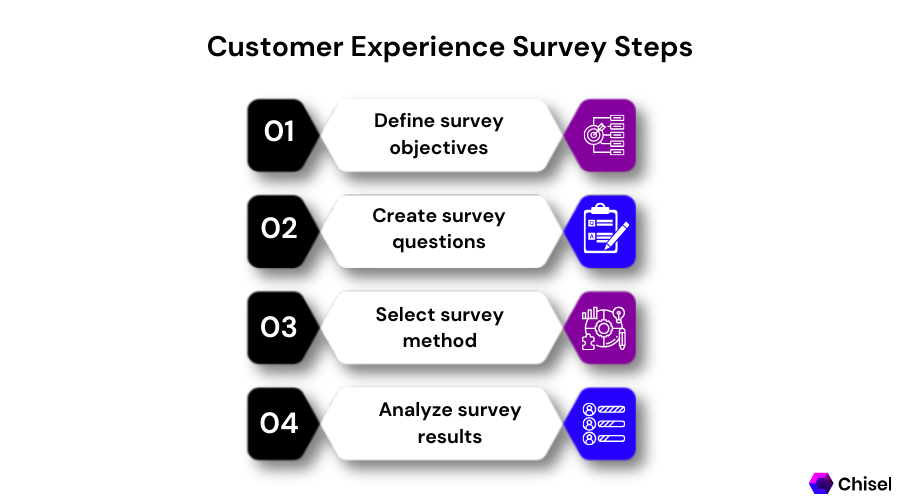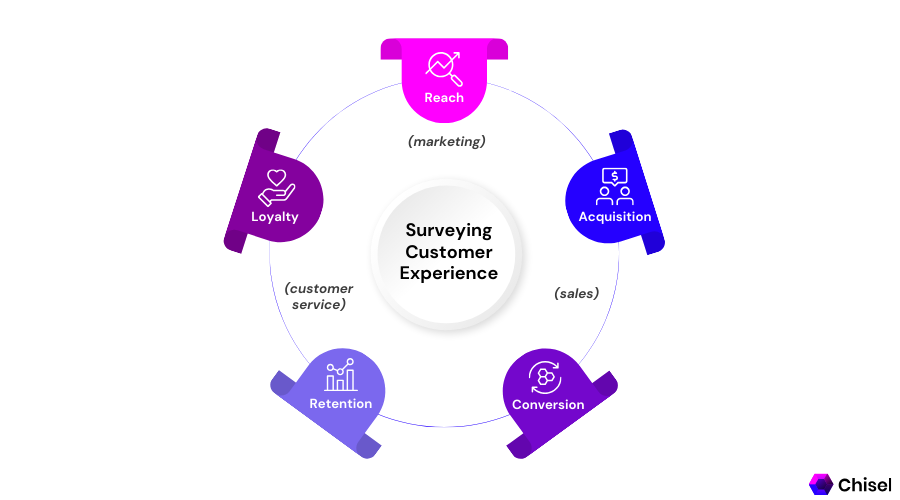How to Craft an Effective Customer Experience Survey?

Looking to improve your customer experience? Well, you’re in luck! Crafting a compelling customer experience survey is how to understand your customers’ needs and enhance their satisfaction.
Where do you begin? It’s all about asking the right questions. You want to gather valuable feedback without overwhelming your customers, so striking a balance is crucial. By carefully selecting the questions that matter most, you can uncover insights that will guide your business decisions.
But it’s not just about the questions. The structure of your survey plays a significant role too. Organizing your survey logically and engagingly can keep your respondents interested and ensure accurate and reliable responses.
And here’s the best part: armed with the insights from your customer experience survey, you can tailor your products, services, and interactions to meet your customers’ needs and expectations. It’s a win-win situation!
Ready to dive in?
How to Conduct a Customer Experience Survey
Conducting a customer experience survey is a useful approach for businesses to gather customer insights and feedback. It helps understand customer satisfaction levels, identify improvement areas, and make data-driven decisions.
Let us guide you through conducting a customer experience survey, from deciding what to study to analyzing the results.

Step 1: Decide What You Want to Study
Before creating a customer experience survey, it’s essential to determine the specific aspects of your business or service you want to study.
Are you looking to assess overall customer satisfaction, evaluate a recent product launch, or gather feedback on a particular service? Defining your research objectives will help you design targeted survey questions and obtain meaningful insights.
For example, suppose your target audience is software development. In that case, you should study factors such as user experience with your software, satisfaction with customer support, ease of implementation, or suggestions for future enhancements.
By focusing on specific areas, you can tailor your questions to gather feedback directly related to your objectives.
Step 2: Select the Appropriate Survey
Once you have identified your research objectives, it’s time to select the appropriate survey method. There are various survey types, including online surveys, phone interviews, in-person interviews, or paper-based questionnaires.
The selection depends on factors such as your target market, the nature of your business, and the resources available.
Online surveys can be a practical choice for software development businesses targeting a tech-savvy audience. They can easily get distributed through email, social media platforms, or embedded in your website.
Online surveys also offer the advantage of anonymity, allowing respondents to provide honest feedback without hesitation.
Step 3: Determine the Kinds of Questions to Ask
Crafting well-designed survey questions is crucial to obtain accurate and actionable data. Depending on your research objectives, you can use open-ended and closed-ended questions.
Open-ended questions allow respondents to provide detailed feedback in their own words. They help capture unique insights and uncover unexpected trends.
For software development businesses, you can ask open-ended questions to understand specific pain points users may be experiencing or gather suggestions for improvement.
Closed-ended questions provide respondents with predefined options, such as multiple-choice or rating scale questions. They are easier to analyze and quantify, enabling you to generate statistical data.
Closed-ended questions can measure satisfaction levels, gather demographic information, or prioritize feature requests. Ensure to include a balanced mix of questions to gather comprehensive feedback from your target audience.
Step 4: Create and Distribute Your Survey
With your research objectives and question types in mind, it’s time to create your survey.
- Use a user-friendly survey platform: There are several platforms available that offer customizable templates and drag-and-drop interfaces. These tools streamline the survey creation process and provide branding, question logic, and survey branching options.
- Design your survey with a clear and logical flow: Begin with an introduction that explains the purpose of the survey and assures respondents about the confidentiality of their responses. Arrange questions in a logical order and use clear language that is easy to understand. Keep the survey concise to avoid respondent fatigue and increase completion rates.
- Distribute your survey to your target audience: If you have an existing customer database, you can send survey invitations via email. Social media platforms and website integrations also offer convenient ways to reach a broader audience. Ensure the survey is easily accessible and compatible with various devices, including desktop computers, laptops, tablets, and smartphones.
- Promote your survey through multiple channels: Utilize social media platforms, company newsletters, and website banners to increase awareness and encourage respondents to take the survey. Moreover, you can offer incentives, such as discounts or entry into a prize draw, to motivate participation and increase response rates.
If you’re wondering which platform is the ideal choice for conducting a customer experience survey, look no further than Chisel.
The top-notch product management tool offers everything you need, from roadmap management to feedback analysis, making it the ultimate solution for your needs.
Sign up for Chisel’s Free Forever Version here.
Step 5: Analyze the Results
Once you have collected sufficient survey responses, it’s time to analyze the results. Effective analysis provides valuable insights that can inform decision-making and improve customer experience. Here are some steps to consider when analyzing your survey data:
- Data Cleaning: Start by reviewing the data for any incomplete or inconsistent responses. Remove any outliers or responses that do not meet the required criteria. It ensures the accuracy and reliability of your analysis.
- Quantitative Analysis: Begin by summarizing the closed-ended questions using statistical measures such as averages, percentages, or charts. It will help you identify your respondents’ patterns, trends, and overall satisfaction levels.
- Qualitative Analysis: Review the responses to open-ended questions and identify common themes or sentiments expressed by the respondents. Categorize the feedback into relevant groups to gain a deeper understanding of specific issues or areas of improvement.
- Cross-Analysis: Look for correlations and relationships between different survey questions. For example, you can analyze whether satisfaction levels differ based on demographics or if specific features are more critical to certain customer segments.
- Actionable Insights: Based on your analysis, extract critical insights and actionable recommendations. Identify areas of strength and areas for improvement, and prioritize actions based on their potential impact on customer experience.
Remember that the analysis is an iterative process, and you may need to revisit the data multiple times to gain a comprehensive understanding.
Best Practices for Customer Experience Surveys
When conducting customer experience surveys, following best practices to gather valuable insights and obtain accurate feedback is essential. Let’s explore each of them in detail:
Try to Keep Your Survey Brief, With No More Than 10 Questions
Extensive surveys can discourage respondents, leading them to abandon or hastily complete them without providing thoughtful answers.
To get the most out of your survey, keep it to no more than ten questions. It will help you get higher completion rates and more meaningful data.
Here are some tips for keeping your survey brief:
- Focus on the most critical questions.
- Use clear and concise language.
- Avoid asking too many open-ended questions.
- Use branching logic to skip irrelevant questions.
- Offer incentives for completing the survey.
Keep Your Wording Simple, Neutral, and Free of Any Leading Inquiries
The way you phrase your survey questions can greatly impact the quality and reliability of the responses you receive. Here are a few tips to help you write clear, neutral, and unbiased survey questions:
- Use simple, everyday language. Avoid using technical jargon or industry-specific terms that your respondents may not understand.
- Keep your questions concise. Long, complicated questions are more likely to be misunderstood.
- Avoid leading questions. A leading question suggests a particular answer. For example, “Do you agree that our new product is the best on the market?” This question leads because it indicates that the respondent should agree that the product is the best.
- Be neutral in your tone. Your survey questions should not express any opinions or beliefs. For example, instead of asking, “Do you think our customer service is excellent?” you could ask, “How would you rate our customer service?”
Simplify your life with Chisel’s User Survey tool, designed to make things easier for you. Choose from ready-made templates that suit your preferences, or create your own. It’s all about convenience and customization with Chisel, empowering you to conduct surveys effortlessly.
Sign up for Chisel’s Free Forever Version here.
Understand When and When Not to Utilize Open-Ended Inquiries
Open-ended questions allow respondents to provide detailed, descriptive answers in their own words. They can be a valuable tool for gathering qualitative data and uncovering specific details or opinions you may not have anticipated. However, it’s important to use open-ended questions strategically. They are not always the best choice for every survey.
Closed-ended questions, on the other hand, provide predefined response options. It makes them easier to analyze and more efficient for gathering quantitative data. However, closed-ended questions can limit the amount of information you collect.
The best way to use open-ended questions is to balance them with closed-ended questions. It will allow you to gather both qualitative and quantitative insights effectively.
Limit Your Distractions
When designing your survey, it’s crucial to minimize potential distractions that could detract from the respondent’s focus and attention.
Extraneous elements, such as excessive branding, advertisements, or unnecessary graphics, can divert participants’ attention away from providing thoughtful responses. Keep the survey layout clean, visually appealing, and easy to navigate.
Reducing distractions creates a more engaging and user-friendly survey experience, increasing the likelihood of obtaining accurate and meaningful feedback.
To Encourage Involvement, Offer a Little Incentive, Such As Entry Into a Drawing
A small incentive can be a great way to encourage people to participate in your survey. It can also help to increase the quality of the responses you receive.
There are many kinds of incentives you can offer, such as:
- A chance to win a prize
- A discount on future purchases
- A free product or service
- A donation to a charity of the respondent’s choice
When choosing an incentive, you must consider your target audience and what would be most appealing to them. You also want to make sure that the incentive is not so significant that it could bias your survey results.
Before Sending It Out, Carefully Evaluate It
Evaluating your survey before sending it out is essential to ensure its effectiveness and gather reliable data. Here are some things to keep in mind:
- Check for errors. Carefully review the survey for any grammatical errors, spelling mistakes, or formatting issues that could impact the clarity of the questions.
- Test on different devices. Test the survey on other devices and platforms to ensure it is mobile-friendly and accessible to all respondents.
- Get feedback from others. Ask a few people to take the survey and give you feedback on the questions, the flow, and the overall experience.
Benefits of Conducting Customer Experience Surveys
Conducting customer experience surveys can provide many benefits for businesses of all sizes. Here are some of the key benefits:
Gain Valuable Feedback
Customer experience surveys provide a valuable opportunity to gather direct feedback from customers. Businesses can obtain specific insights into their customers’ experiences with their products, services, and brand by asking targeted questions. This feedback helps identify areas of success and areas that need improvement, enabling data-driven decision-making to boost the customer experience and meet their expectations effectively.
Understand Your Customers’ Perspectives
Customer experience surveys offer a deeper understanding of customers’ perspectives. These surveys delve into their thoughts, emotions, and motivations, helping businesses develop a comprehensive view of their needs and preferences.
Companies can tailor their offerings by better understanding customers to align with their desires, creating a more personalized and resonating experience.
Identify Trends
Customer experience surveys are a powerful tool for identifying emerging trends within the customer base. The collected data helps identify patterns, preferences, and shifts in consumer behavior.
By staying ahead of the competition and proactively adapting strategies, products, or services to cater to changing customer demands, businesses can position themselves as industry leaders and gain a competitive advantage.
Help Determine Your Priorities
Conducting customer experience surveys enables businesses to prioritize their initiatives effectively.
By analyzing feedback, companies can identify areas that require immediate attention and allocate resources accordingly. Addressing pain points, improving specific features, or enhancing the customer journey becomes easier. It ensures efforts are focused on what truly matters to customers and driving long-term success.
Retain Existing Customers
Customer retention is crucial for sustainable business growth, and customer experience surveys are pivotal. By actively seeking feedback from existing customers, businesses demonstrate their commitment to satisfaction and show that customer opinions matter.
When customers feel heard and valued, they are more likely to remain loyal.
Addressing their concerns and improving based on their feedback strengthens the business’s and its customers’ bond, fostering long-term loyalty and retention.
Boost Customer Loyalty
Customer loyalty is the foundation of a successful business, and customer experience surveys contribute significantly to fostering and enhancing it. These surveys provide a platform for customers to express their opinions, share positive experiences, and provide suggestions for improvement. When customers see that their feedback leads to tangible changes, trust, and loyalty toward the brand deepen.

By consistently seeking and acting upon customer feedback, businesses can create a customer-centric culture that encourages loyalty, advocacy, and positive word-of-mouth.
Conclusion
Conducting customer experience surveys is essential to understanding and improving your business’s relationship with its customers.
By following the guidelines and best practices discussed in this article, you can gather valuable insights. These insights will help you enhance customer satisfaction, refine your products or services, and stay ahead of the competition.
So, what steps will you take to implement a customer experience survey for your business? Are there any specific best practices that resonate with you?
Remember, listening to your customers is the key to delivering exceptional experiences and fostering long-term loyalty.
